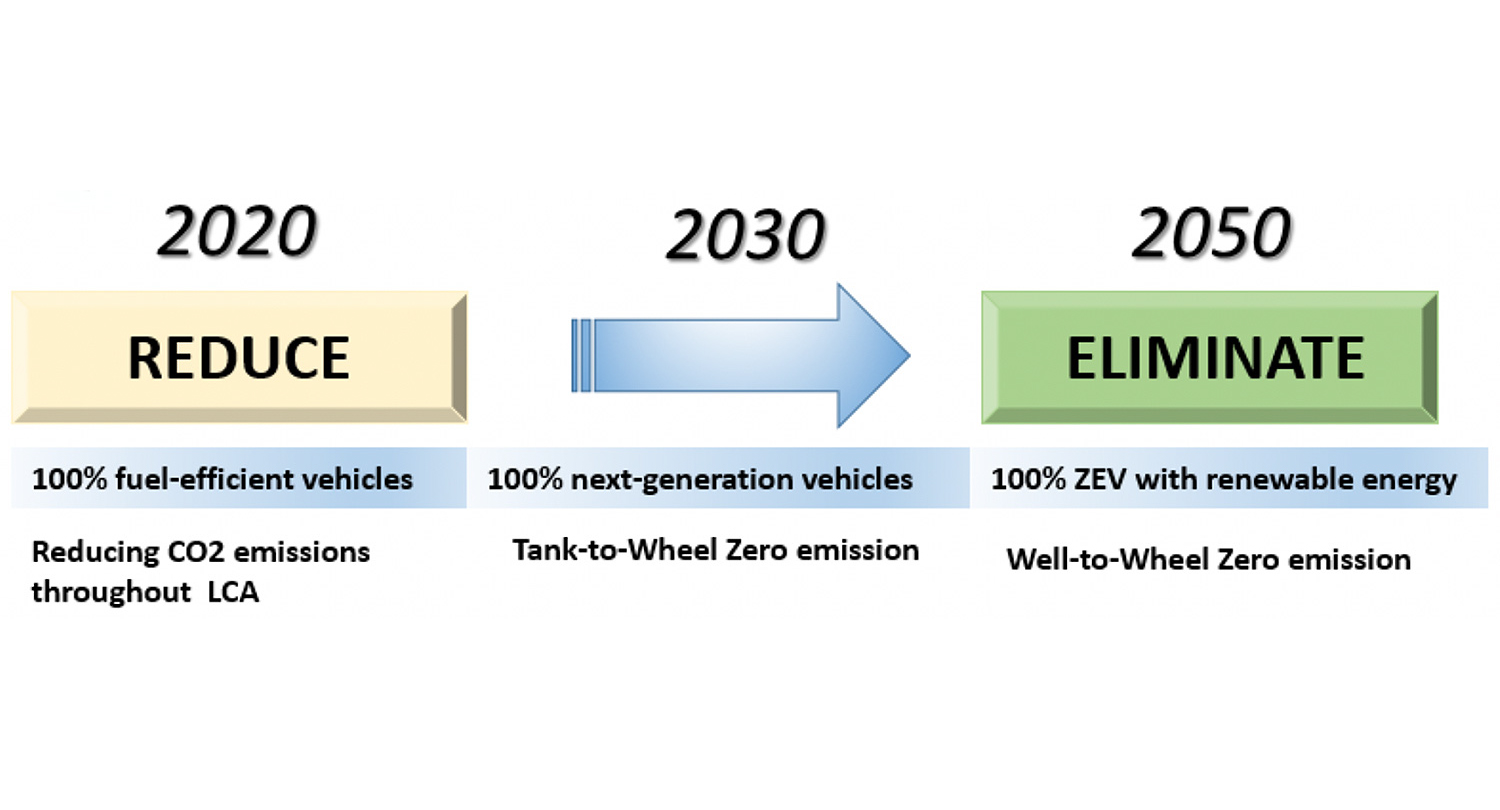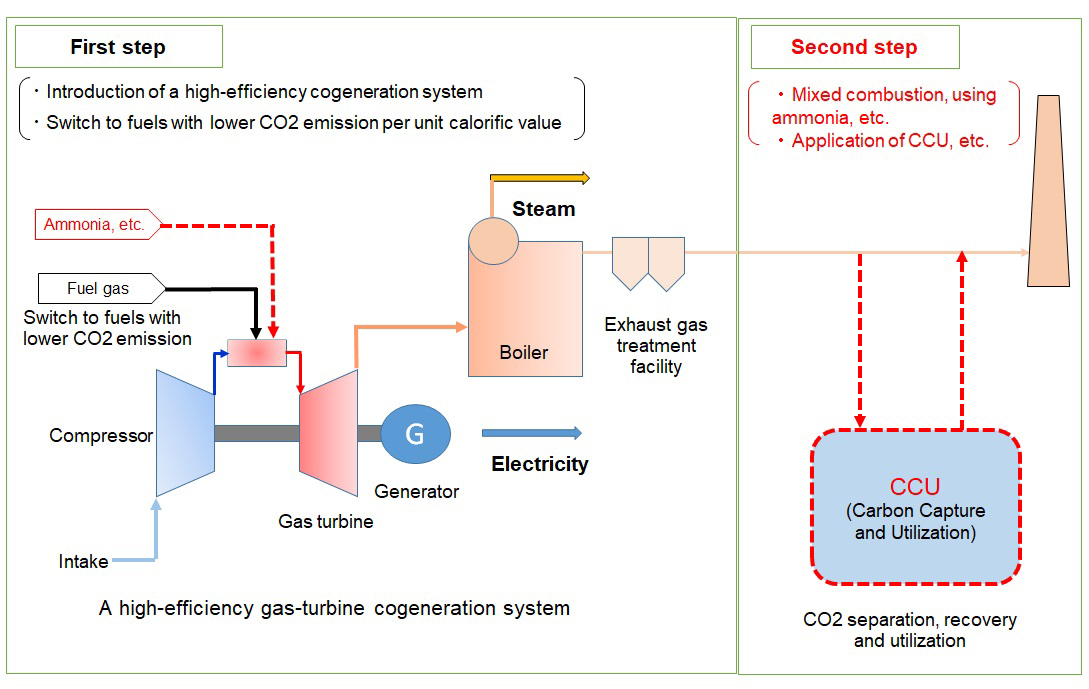The chemical industry as a solution provider for Climate change issues
JAPAN CHEMICAL INDUSTRY ASSOCIATION
Outline
Japan Chemical Industry Association (JCIA) published “Chemical Industry’s VISION on Global Warming Countermeasures (the vision)” on 22nd May, 2017.The vision shows three key potential solutions beyond 2050 as the chemical industry is the solution provider.
(1) Carbon circulation of raw materials, (2) Processes for minimizing energy use, and structural shift, and (3) Reduction of GHG emissions throughout product life cycle. In addition, JCIA will contribute to avoid GHG emissions through the value chain by diffusion of chemical industry’s technologies, products, and its best practices globally.
Description
As a solution provider, the chemical industry will focus on the following key solutions in order to achieve the vision.
(1) Carbon circulation of raw materials
It is necessary to promote a diversification of feedstocks that leads to carbon circulation and minimize GHG emissions in the life cycle of chemical products. As the countermeasures, based on a long-term perspective, chemical industry will promote carbon dioxide capture and utilization (CCU), use of biomass feedstock, and utilization of natural gas as fuel and/or feedstock, and use of methane hydrate resources. At the same time, chemical industry will work on the development of technologies necessary for reuse of waste (waste plastic etc.) as a carbon source. Also, chemical industry will thoroughly promote highly sophisticated use of fossil feedstocks. Regarding the use of biomass as raw materials, chemical industry will promote technological development for two cases, one is to use biomass as it is, such as cellulose nanofibers and lignin, etc., and the other is to use it as raw material for basic chemicals.
With regard to bioplastics (plastics produced from biological resources), it is expected technology development, not only with cost reduction, but also with adding nonconventional value, such as coloring and controlling sterilizing properties owing to the biological origin of the materials, which have never been before to improve its performance in order to establish its business model.
Along with above these technological developments, it is also necessary to establish the system to effectively collect the carbon source for chemical processes by promote the utilization of AI when biomass and waste as the carbon source were collected and transported.
(2) Processes for minimizing energy use, and structural shift
It is necessary to promote technological innovation to achieve energy savings on an extraordinary scale in the manufacturing process. Firstly, it is to develop membrane separation processes as the alternative distillation processes, which consume a lot of energy in the manufacturing process. With regard to high-value-added functional chemicals, it will promote to develop flow reactors (micro reactors) and bio generations as new and highly energy saving ways to produce, instead of the conventional batch production method of manufacturing, which spend huge energy for many product types in small quantities. It will also aim to realize epoch-making methods that carry out a reaction in a transportation process equipped with a new reaction system. To reduce the energy use ratio by fossil fuels’ combustion, it will develop innovative technologies to exchange electric energy to thermal energy, such as resistance heating (Joule heat), microwave heating, induction heating, and heat pumps for industrial applications. Moreover, it will develop innovative processes without energy loss, such as inserting a heat-absorbing process or repeating heating and cooling after a process that emits heat. Furthermore, in order to increase energy efficiency, it will combine the processes of heat generation and heat absorption and will utilize waste heat. Then it will establish an energy management system by going beyond individual company within local petrochemical complex. As an effort by corporates’ collaboration, it will build a mechanism for effective utilization of materials within an industrial complex. Parallel to above these efforts, it will promote the utilization of AI in applications as establishing technologies such as minimizing the energy that has conventionally been required for regular repairs, predicting the lifespan of a production plant that transcend conventional concepts and in achieving feedforward control of processes that can accommodate various types of products, handle operation switching, and cope with disturbances.
(3) Reduction of GHG emissions throughout product life cycle
It will commercialize high-insulation materials, highly lubricating materials, etc., as new materials bringing the entire value chain innovation. It will develop high-strength lightweight materials (such as CFRP, CFRTP) and will proactively propose them to downstream user industries and will establish the system of cooperation. It will finally contribute to the energy savings and minimizing emissions of GHGs throughout the product life cycle. Rather than adhere to the conventional business model of responding to user requests, it is expected for chemical industry to establish a new business model wherein chemical industry can make proposals to the final product manufacturers in anticipation of the potential needs of the end user/customers. By using the business model, the chemical industry can propose product designs and use scenarios that will lead to overall reductions of GHG emission. Finally, chemical industry will play a leading role along the value chain and will establish its position as a solution provider to reduce GHG emission and achieve climate goals.
(4) Expansion of the carbon-circular economy at the global level
Chemical Industry has been contributing to worldwide reduction of GHGs emission by the overseas deployment of its experience, technologies, products, and know-how cultivated by the establishment of a carbon-circular economy in Japan. Through bilateral dialogue and at the international organizations’ meeting, chemical industry has sought opportunity to make its experience, technologies, products, and know-how widely known as indispensable to sustainable society and has sought the way for deployment of the Japanese technologies and business models in emerging countries. The following items should now begin to be tackled as actions based on the vision.
JCIA will tackle the following items as actions based on the above-mentioned priority efforts from now on.
(1) The chemical industry should get all the collective effort by working together with other industries, the government, and academia/universities to formulate programs for developing innovative technologies.
(2) In order to contribute to significant GHG emission reductions overseas, the chemical industry will prepare for establishing the approach to propose the innovative technologies brought by the chemical industry to the international organizations for the internationally deployment of the technical strengths in the way of economic rationality.
(3) The chemical industry should establish a system of collaboration that transcends conventional industrial boundaries and propose a new social system in order to bring about social innovation throughout the entire value chain.
Similar Innovation Challenges
Achieve 2050 decarbonization target with Net Zero Energy House!
Sekisui House, Ltd.
Achieving net-zero emissions by promoting renewable energy use through both our monozukuri and products.
DAIWA HOUSE INDUSTRY CO., LTD.







